Articles & Guides
Editorial Plan: how to build a winning one
in a nutshell
Read how to build the ultimate editorial plan (based on data, not just opinions) in 5 steps. A complete guide with template, examples and downloadable Canvas.


Don’t have time to read it all?
Here’s a brief summary of the key points in this guide.
What is the editorial plan?
It is an organizational document used to define a priori the content that will be published on social platforms, blogs, websites, newsletters, magazines, and editorial titles. The editorial plan:
- • Concerns both online and offline realities
- • Can be a paper or digital sheet
- • Requires the ability to recognize the objectives to be pursued in relation to different types of content, target audience, and the appropriate tone of voice
[DIVE IN]
Why should I create an editorial plan for publishing content?
Work planning is functional to survive in an ultra-competitive digital world. It allows to to limit or eliminate errors, avoid overlapping and unprofitable topics, and maximize effectiveness. We could summarize some benefits related to the implementation of an editorial plan:
- • Absence of improvisation
- • Continuity in the proposal of content
- • Medium or long-term vision
- • Time savings
[DIVE IN]
How can I build the editorial plan?
First and foremost, to shape an effective editorial plan, it is essential to have the SMART (Specific, Measurable, Achievable, Relevant, Time-Bound) goals of your publishing strategy firmly in mind. Then, you can follow these 5 steps:
- 1) Outline the scenario (brand knowledge)
- 2) Define channels, topics, and tone of voice
- 3) Build the editorial calendar
- 4) Use advanced tools for editorial plans (Trello, PostPickr, Semrush…)
- 5) Create content
[DIVE IN]
What is cornerstone content?
Cornerstone content is the basic building blocks of any blog, site, or social page. These articles:
- • Deal in depth with the core concepts of a person, an activity, or a business
- • Condense inside them an overview of the company’s target industry
- • Describe the company’s offerings and strengths
- • Are at least 2,000 words long
- • Are more insightful, and better edited than “everyday” articles
[DIVE IN]
LEARN TO RIDE
Ready to surf the digital wave and become a leader in your industry? Join Execute.Club, where executives and managers like you can access resources, connect with peers, and get the no-nonsense help you need to succeed in the digital era.
Enter the ClubIntroduction
The editorial plan is the fundamental tool for building an ongoing web presence, scheduling the content to be distributed on the used pages, and responding to communication and marketing objectives (lead generation, awareness, loyalty). If publishing requires a simple click, everything preceding it requires time, care, and expertise. In other words, it requires a strategic editorial plan.
Introducing the Editorial Plan

A competitive company today cannot ignore the importance of consolidating its image on the internet. Digital Transformation requires immediate, effective communication that persuades potential customers of the quality of products and services. And, above all, that reflects brand reliability. Businesses, brands, freelancers, and influencers, therefore, must create, organize and publish content.
But the publication of a post on social networks or that of an article on a blog cannot be the result of a random and occasional initiative: it must fit into a strategic and competitive context that has been studied. Achieving considerable results from using online platforms does not mean, in fact, sharing content once in a while in the hope that users will like it. People are bombarded with information and making a difference among the crowd is complicated.
An overview
What is the editorial plan?
The editorial plan is an organizational document used to define a priori the content that will be published on social platforms, blogs, websites, newsletters, magazines, and editorial titles. As can be guessed, then, it concerns both online and offline realities. Its definition includes both the preparatory work of coordinating and setting content and the operational scheme that summarizes it.
DOWNLOADABLE FILES
- Editorial Plan Canvas – Download now!
It can be a paper or digital sheet, in which to enter a series of information aimed at keeping track of the activities to be carried out on the chosen distribution channels and remain consistent with the communication strategy adopted. But a good editorial plan requires first and foremost the ability to recognize the objectives to be pursued in relation to the different types of content, the target audience, and the most appropriate tone of voice.
What does the editorial plan contain?
So, an editorial plan identifies the content that will be produced within a time schedule. It would be wrong, however, to consider it a simple agenda that reminds of deadlines and plans the workflow. Without an overview which includes the set goals, the expected or desired economic returns, the available tools and much more, the editorial plan turns into a simple exercise in style, as beautiful as it is useless.
Thus, depending on the set cadence, it will include all materials to be published in a specific time frame. This may be weekly, biweekly, monthly, quarterly, semi-annually, and so on. But be careful: even if the defined time frame were short, it is important for those involved in drafting it to follow an outline capable of considering broader periods.
What is the editorial plan for?
Work planning is functional to survive in an ultra-competitive digital world. The need to establish hierarchies in the news overload requires promptness and optimization of time to prevent the rush to get there first from negatively affecting the quality of informational or entertainment content.
So, the editorial plan is important to limit or eliminate errors, avoid overlapping and unprofitable topics, and maximize effectiveness. A strategic task, in short, for all those involved in periodically creating and sharing online or print content. It allows, in fact, to rationalize ideas and insights in order to build a solid communication structure that ensures consistency in publication and never leaves you short of ideas.
Ultimately, we could summarize some benefits related to the implementation of an editorial plan:
- • absence of improvisation, which, except for strokes of genius, is rarely a good idea
- • continuity in the proposal of articles and any type of content that generates impressions, engagement and interaction from users
- • medium or long-term vision that respects the communication strategy adopted, to avoid running out of materials and then having to rack your brains in a hurry
- • time savings, hands down the most significant benefit of good organization
5 Steps to build an Editorial Plan
How to build an editorial plan: the 5 steps to follow
First and foremost, to shape an effective editorial plan, it is essential to have the SMART (Specific, Measurable, Achievable, Relevant, Time-Bound) goals of your publishing strategy firmly in mind. Successful planning, in fact, cannot claim to share something without a logic as it would confuse readers and the meaning of the page would be lost. Thus, an editorial plan represents the result of a preliminary series of analyses, reasoning and operations involving a multiplicity of factors.
1) Outline the scenario
The process that leads to drafting a content plan begins with brand knowledge. Indeed, it makes no bones about the fact that companies and professionals should be the first to know their brand, its strengths, and weaknesses (perhaps following a SWOT analysis). Otherwise, the risk is communicating a misleading message or identifying the wrong target audience. Values, history, products, and services, but also opportunities and threats – all essential elements for the briefing phase that precedes the actual compilation of the plan.
After an introspective journey, it is time to analyze competitors for inspiration, understanding how the industry works and how audiences behave. A step aimed at intercepting the most relevant and appreciated content and then repurposing it in an original form. You have already learned that monitoring competitor behavior does not mean copying, but searching for a base from which to develop new ideas to deserve your own community.
A third, very crucial player in the preparation of the editorial plan is the target audience, i.e. the people you want to address. These are the so-called “reader personas” (corresponding to the buyer personas of a sales strategy), ideal types that encapsulate precise attributes. You can go several ways to identify them: studying search queries to understand needs and desires of the moment, comparing traffic in the channels currently in use, reading insights from social media, and so on.
Each publication, then, must be designed around well-defined goals. They could relate to retention, lead generation, brand reputation, generating traffic to the website, or simply intercepting questions related to the product or service offered. They vary depending on the subject, but the important thing is that they are clear.
It must be said (and said again, and said again) that in an overcrowded digital space getting recognized and appreciated is by no means a given. Therefore, the communication style adopted must be skillfully able to avoid the content conveyed from being repetitive, trivial, or similar to a promotional message every time. The keyword is entertain, in order to get users to interact without getting bored or losing interest.
We’re almost there: the ground is almost completely cleared to move on to the next steps of building your publishing plan. First, however, be sure to master the specific features of the individual channels identified. Each platform, in fact, has formal and usage specificities, which allow for different content management and variable modes of use. Recognizing the peculiarities of each medium implies creating content that is consistent with both context and user activity.
Lastly, there remains the consideration of available resources. You don’t want to be opting for content that is beyond your ability to produce. Usually, however, the production aspect is handled by professionals ranging from social media managers to graphic designers, copywriters to video makers, and many others.
Give it a try with a SWOT analysis
I mean, you should have realized that whether the editorial plan is for the blog, the newsletter, Instagram or Facebook account, the approach doesn’t change. You must outline the scenario, starting with a brand analysis that allows you to understand what your strengths are.
I recommend you to begin with a SWOT analysis, in order to better understand who you are, and what you do to be special and to make a difference. It is a tool designed to identify strengths, weaknesses, opportunities, and threats.

Fill in these spaces to get a clear idea of the structure you want the editorial plan to have. Set goals deliberately – they can be either short-term or long-term. That way you will also define how long the editorial plan should be. Assess the tone of voice and the values that shape your content. The editorial plan needs this as well.
2) Define channels, topics, and tone of voice
Once the necessary analytical basis has been mapped out, the slightly more practical time will come for you to choose the target channels (of whose operation, at this point, you should be an expert), specify the topics you intend to cover (and the possible sections in which to group them) and the tone of voice that will condition each publication.
Building an editorial plan: choosing channels
Newspapers, magazines, blogs, websites, and especially social media: an editorial plan cannot work the same way for every variable on the same platform, let alone across different platforms! Indeed, we have seen that channels enjoy their own qualities that distinguish them from one another. Therefore, first you define the preferred channel, then proceed to design its content distribution.
Let’s take, for example, Facebook: the algorithm behind the social network created by Mark Zuckerberg rewards mostly videos, while links are now in danger of getting lost in the traffic jam of memes, photos and status updates. Facebook needs to be fed with content, both from pages and from personal profiles (especially if aimed at personal branding).
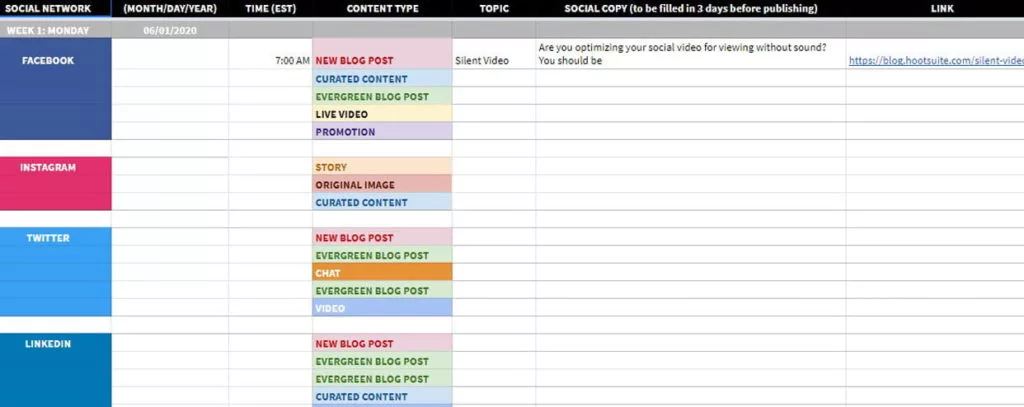
Instagram also calls for action on multiple fronts: feed posts, reels, stories, and IGTV videos are all tools to consider. Instead, if the goal is to produce and share posts related to the world of work, the editorial plan will target LinkedIn capabilities. Does the target audience identified above consist of the very young Generation Z? No problem, you will need to develop an editorial plan for TikTok.
Beyond social networks, newsletters also require a plan, since, for example, you will need to determine how many to send per month, or which topic to address this week. To make a long story short, cross-mediality would seem to be the winning choice: spread your presence across multiple channels in a manner consistent with the scenario outlined, and for each channel formulate the relevant editorial plan.
A well-crafted editorial plan will know how to quickly shape itself according to evolving trends and hot topics of the moment, publication needs, or results recorded with already distributed content. In any case, regardless of the type of editorial plan, following the topics of discussion or the most highlighted news stories can always be useful.
Topics of an editorial plan
Deciding which topics to cover and on which to base the following publications is always a problematic task, since the tastes of the public are, by nature, subjective. Therefore, the success of a topic cannot be predicted with certainty. But you can still identify some basic macro-areas from which to extract the narrative lines of the editorial plan.
For example, you can talk about the product: pointing out its features, telling its peculiarities, explaining its ways of use and, why not, throwing in some trivia. Another great point of reference are values, universes, ways of being that a brand shares with the people themselves. Or, more related to circumstances (and social planning), are events, anniversaries, and days that occur during the calendar year. We’re talking about holidays and initiatives of interest such as Fashion Week, Black Friday or Valentine’s Day.
An important practice for selecting topics and shaping content accordingly would be to keep a constant eye on post insights. The data-driven approach – in this case, popularity of posts among the audience – is never a bad idea, although, in the social case, it should be judged over the long term.
Lastly, moving from abstract topics to concrete content requires considering target audiences and underlying motivations. Indeed, a frequent mistake of editorial plans is their self-referentiality: too often they speak to people rather than with people. To fix this, you should find a communication key that can engage, entertain, and excite despite the fact that you are talking about products or services. All, with a consistent and coherent tone of voice.
Editorial plan and tone of voice
When writing text, choosing images, and managing a page, a brand must demonstrate a recognizable and distinctive character. It is the tone of voice, a very important aspect underlying the editorial plan that can be chosen according to:
- • social channel and related communication style
- • target audience (age, gender, habits, preferences, needs)
- • mission and goals, as the direction of a brand deserves to be properly expressed
3) Calendar content

Okay, now you know why you communicate, what you want to convey, where, how and for whom. You can move on to the actual planning, but do not fool yourself: this is only the beginning. First, though, an essential clarification: editorial plan and editorial calendar, you should have already guessed, are not the same thing. The editorial plan, in fact, is contained and spread out in the calendar, which, on the other hand, is an Excel spreadsheet (or other format, we’ll see) in which deadlines, day and time of publications, possible recurrences or marketing influences for ad hoc content creation, and so on, are explicitly indicated.
So, the calendar and the directions given will vary depending on the type of publishing plan selected. Either way, you will need to include all the specifics of the content you intend to share. The most popular questions at this stage usually concern the number of posts and their publication dates. Be wary of anyone who claims that there are perfect numbers and prime times: the only certainty is that all channels and all audiences are different from each other. Of course, there are a number of metrics to take into account – statistical data such as accounts reached or number of interactions. But consider that, as is often the case, the difference is played out on the level of quality of outputs on the network, not their quantity.
Depending on the type of calendar you are going to compose, some decisive points to specify are usually the publication rhythm, delivery dates, the author of the content and the details that will accompany the content (category, tags, hashtags, SEO elements…). If for an Instagram post, for example, you will start by establishing the hashtags to be written in the description, an in-depth discussion on the company blog will require tags, categories, images and all the elements typically considered by content management systems.
4) Use advanced tools for editorial plans
Even when it comes to the editorial plan, software plays an important role in supporting its compilation. We have seen how, in fact, the editorial plan is an operational document also based on the insights gathered as a result of the analysis of platforms, users, and a number of other variables. Basically, good planning would not need particularly sophisticated tools: a text editor, or possibly project management programs, would suffice.
For example, one of the most widely used tools for calendaring content is the Microsoft Excel spreadsheet. It may not be particularly aesthetically pleasing, but it allows for a clean, understandable, and efficient editorial plan. The main alternative is Google Sheets, a free program included in the Google Docs online word processing suite. Working with the Google package means operating on shared documents, editable by team users at the same time and in real time, but also the possibility of storing useful materials in the Drive folders themselves.
But there are also services that allow you to bypass the spreadsheet format: just think of Google Calendar, a tool for building an essential editorial plan, reporting links, and attaching files. Also very useful is the ability to have an overall, multichannel view of the schedule, overlaying the different editorial calendars compiled. “Calendar” is also the function of the Trello management platform, which allows you to mark content inside (coincidentally) a digital calendar. Finally, coming to the rescue straight from Italy is PostPickr, a tool for managing social media, scheduling publication on different channels, or seeing how a project is planned in the form of an editorial calendar.
Building an editorial plan: monitoring tools
Better to lower expectations now: there are no software and tools specifically designated for making an editorial plan. But there are some that optimize and expedite the necessary analysis examined in the previous points. So let us try to list and present the most useful ones:
• Google Trends is probably the main reference point for having an idea of the most discussed topics online (i.e., what people search for over time). By studying search trends and checking their progress, you can figure out whether it pays to focus on a topic or not (it may now be trite, redundant, or pointing to cannibalization). Twitter trends can help with this too.
• Semrush is the ideal tool for discovering the ranking of websites belonging to competing brands. It gives a clear overview of the topics to be addressed through the study of the most typed keywords. Trends, search volume and cost per click can be derived from them.
• AnswerThePublic offers a free service up to a certain number of searches to work on a key aspect: long tails. These are under-researched but very specific keywords formed by multiple words: the choice of titles to work on, therefore, becomes articulate and detailed.
Anyway, the demographics of your target audience can be scanned from internal market surveys or, more simply, from analytics provided by social networks. Industry experts also agree on the importance of concept maps to ensure that nothing escapes a comprehensive editorial plan. Identifying a focus and looking for related topics helps to shed light on how much time you have, how much content to create and how to link it together.
5) Finally, create content
We have reached the final stage of creating an analytical, accomplished, ready-to-implement editorial plan: the actual realization of researched, chosen, and scheduled content. Yet small and medium-sized businesses still struggle to understand the importance of sharing quality content with the aim of attracting possible new customers. An excellent position on search engines, moreover, makes it more likely to intercept a user during the first purchase phase (i. e., when the need is still latent): a unique opportunity to pick them up, give them advice and guide them along a personalized customer journey.
To sum up, since content is essential, you cannot limit yourself to sporadic and unplanned publishing. After all, content rules since it is directed at the public, the ones truly responsible for the fate of a brand. And so you need editorial plans, tools, but first and foremost concepts to be assimilated. Interesting content must meet at least one of the following characteristics: inform (through possibly exclusive news); entertain (but remaining consistent with the brand); and excite (the most effective aspect, but without pushing it too far!).
The content of the editorial plan: some specific tips
Everyone can run out of ideas, but good planning prevents desperate solutions. In the absence of original content, you can always share posts from other pages or promote external links – always as long as they stimulate readers and are relevant to your industry. However, basically, there are two essential components: copy and visual.
The first is the textual part, which is more or less extended depending on the sharing platform and the communication style adopted by the brand; a solely written post, though, has very low chances of being read. Therefore, text is complemented by visuals: images, videos or gifs that create interaction with users. Other content that can enrich an editorial plan include: static or animated infographics, memes, carousels, podcasts, interviews, tutorials, reels, stories, events, and presentations.
The important thing is to remember that any type of content selected should always seek to meet the consumer’s needs and attract their attention to keep them on the site or page. But each publication must also please the search engine, which – why not, better remind you – rewards useful and interesting content for users if it is written respecting its judging parameters.
And, again, more practical advice: include strategic Call to Action pages and prepare downloadable tools. If you have a website, share its content on social media to gain more visibility and potentially reach more leads. But do it smartly, taking advantage of the peculiarities of each platform to forge an appropriate, newsworthy, and engaging message.
What is cornerstone content?
Web content can be divided into three broad categories: cornerstone, pillar, and cluster. As the name suggests, cornerstone content is the basic building blocks of any blog, site, or social page. They hold up, in fact, the entire structure, since they deal in depth with the core concepts of a person, an activity, or a business. These “milestones” condense inside them an overview of the company’s target industry and describe its offerings and strengths.
So, cornerstone content differs slightly from “everyday” articles: it is at least 2,000 words long, more insightful, and better edited. The length is functional for the inclusion of keywords to generate traffic and be indexed from a SEO perspective. Whatever topic is chosen, it must be exposed as comprehensively as possible, in order to broaden the flow of visitors and then guide them to consult related resources – meaning, the in-depth pages which develop secondary topics of the same theme.
Beyond Cornerstones: Pillar Pages and Clusters
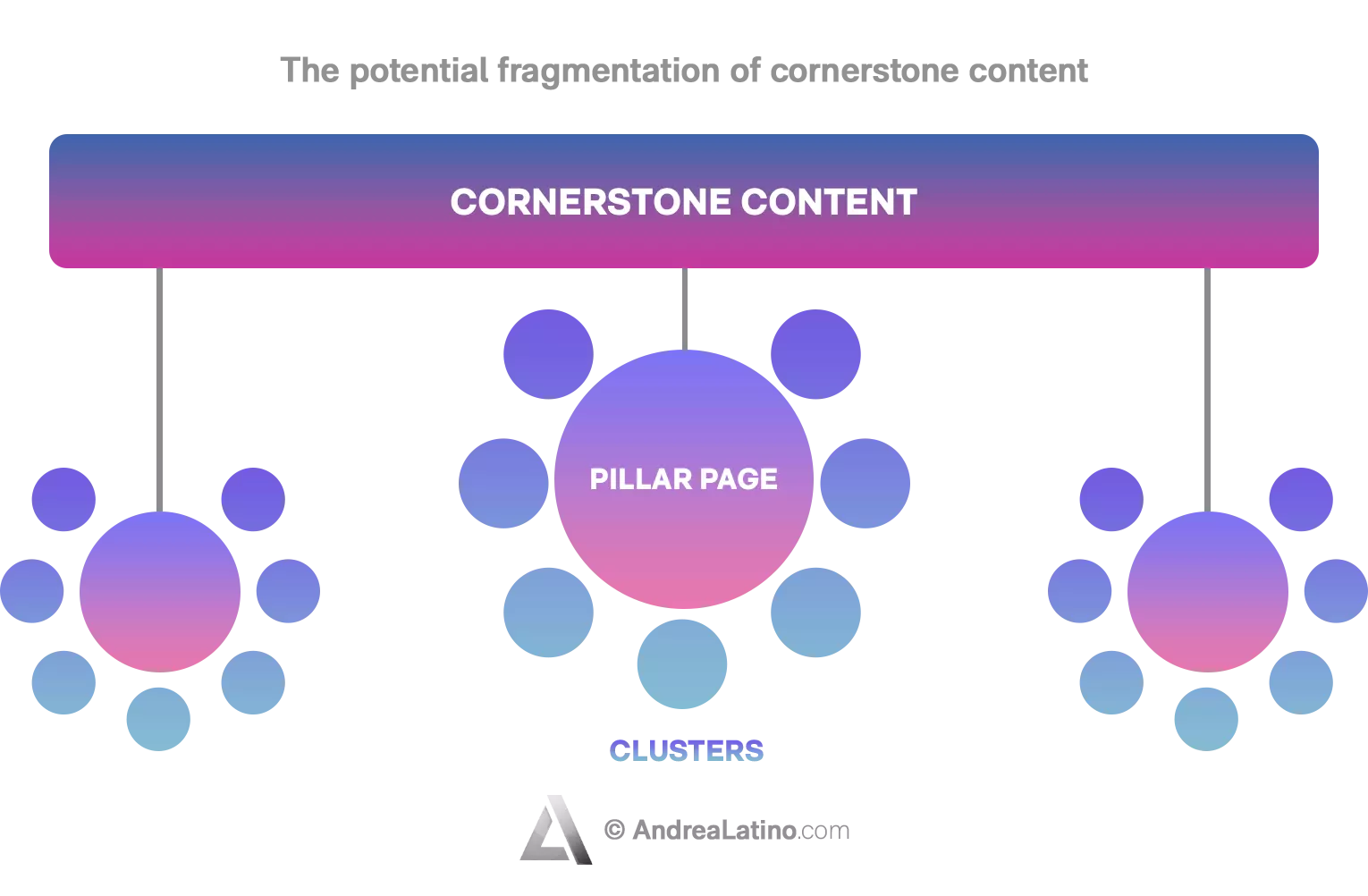
Cornerstone articles encapsulate pillar articles, which are instead – literally – the “pillars”: pages that help intercept the search intention of the user, who is interested only in a specific aspect or point of view related to a certain topic. But cornerstone content is so broad that it can be disentangled into smaller pieces from each pillar page — clusters. Those are articles that branch out and investigate till semantic exhaustion the topics of the cornerstones themselves and can be developed in different ways.
Content types vs Formats
Advertising tycoon David Ogilvy said that what really decides consumers to buy or not to buy is the content of your advertising, not its form. This introduces quite well the crucial distinction I want to emphasize here. Thanks, David. It’s pretty easy, I won’t make it long. In a sense, you can say that a content format is the way you present your content (e.g., an infographic, an article, a video…). The content type, instead, is the direct result of the chosen subject and the circumstances your target audience is going through.
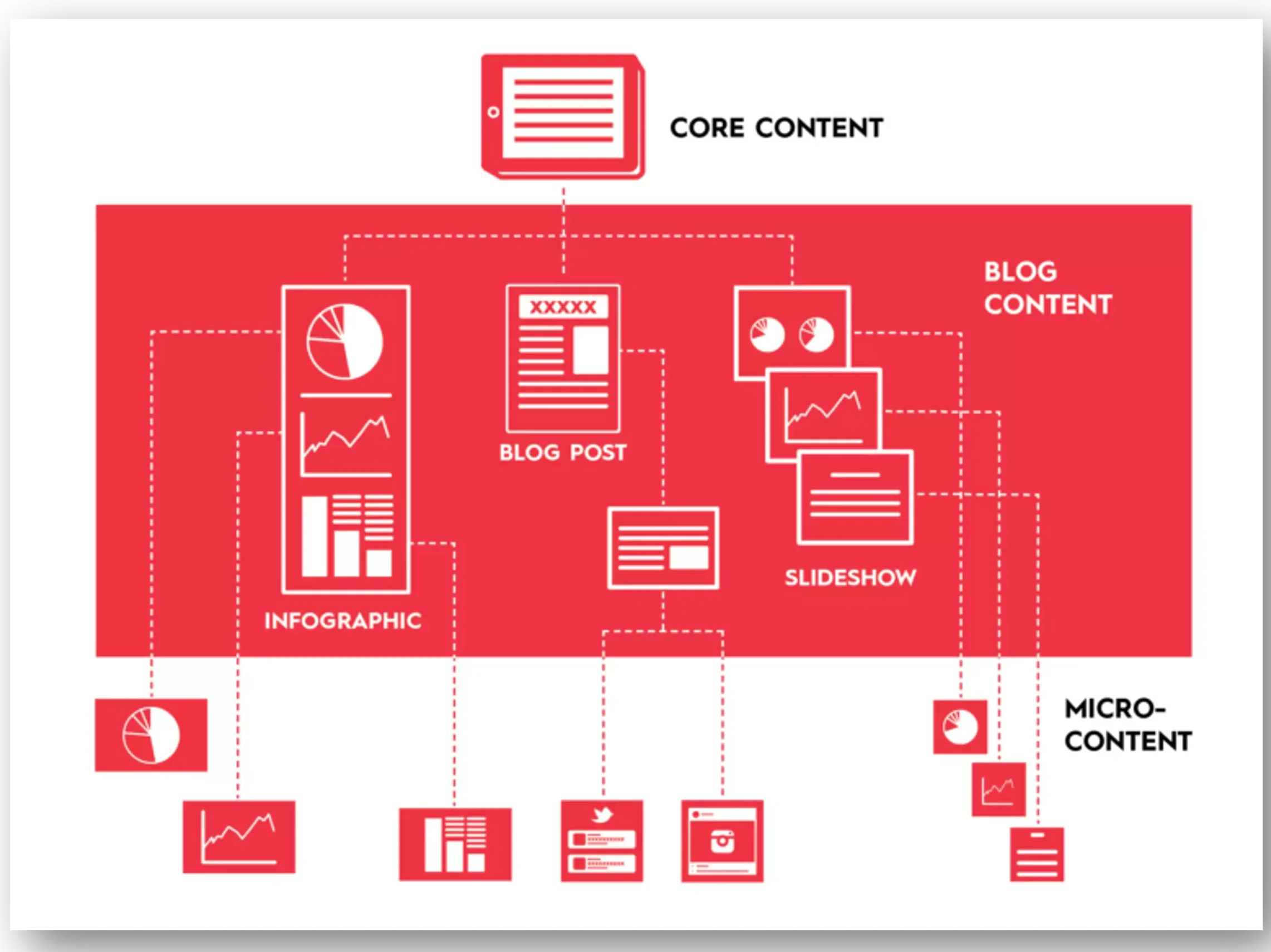
Now, the same type of content can feed different formats. For example, cornerstone content written, let’s say, in the form of a long guide, could be broken down into microcontents (clusters) of different formats (a blog post, a slideshow, and so on). Microcontent creation is a trend which can be applied on any type of product or service, and consists of creating — from a “macro” content — several “micro” contents, employing different formats.
Microformats themselves offer several benefits. First of all, diversification means greater visibility, and brevity is usually related to high shareability. Then, let’s not forget that they can help fill in the “empty spots” within a Digital Editorial Plan. Finally, although they are easy to create (which is already a plus), they can boost creativity and have strong attractive power.
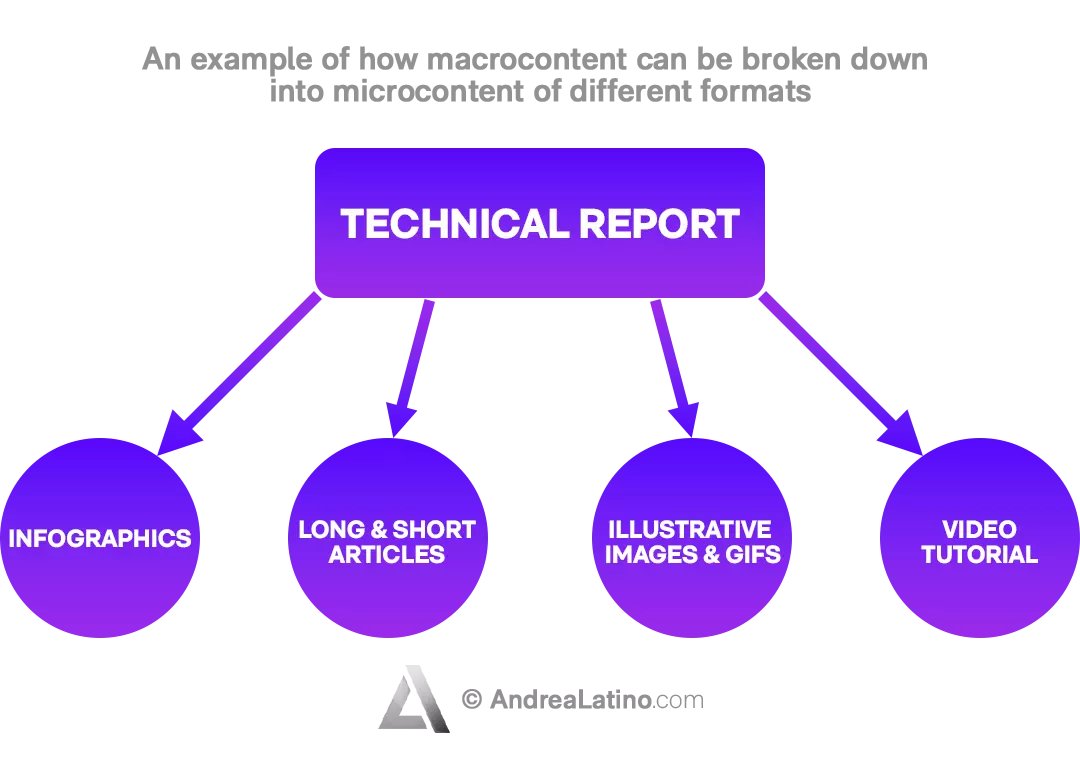
Do you have a Marketing & Sales challenge to tackle? Let’s face it. Together.
C-levels from these companies (AND MORE) relied on my expertise to overcome thEIR CHALLENGES IN THIS AREA. And you can, too.
Can I help you?to make it clear
Is one editorial plan enough?
When dealing with a multiplicity of social profiles, it is inevitable to have to organize content for multiple channels. Consequently, in order to be able to keep everything under control, it will be important to have an overall picture that paints all outgoing content, and a more detailed picture that depicts the activities of individual channels. But don’t get me wrong: the editorial plan must be one and one only.
In order for the materials collected and prepared to be equally effective and valuable, though, it is important to share different content for each channel. This applies as much to different social networks as, for example, to a newspaper that has a print and a digital version. Or, again, if you have an all-digital project, you need to know how to treat publications for the website or blog in a different way than those for the newsletter.
The analytical editorial plan template
We have seen how many steps you need to go through and how many aspects you need to analyze before you can draw up a productive editorial plan. This can be compiled on different types of documents, depending on the complexity you wish to attribute to its structure. Once the document has been chosen, then, it is time to put content into it. Each piece of content will be accompanied by a set of directions, until the desired level of depth is achieved.
The basic elements that should be part of the editorial plan are:
- • the indication of the channel
- • the date of publication (day and month)
- • the specific topic of the post
- • unofficial copy and visuals
- • example title
Pointing out these specifics on paper undoubtedly simplifies the work and aligns from a planning point of view all the people involved in each stage of content creation. But then there are other factors that can further enrich the editorial plan:
- • the category assigned to the content type
- • the keywords
- • mentions and hashtags
- • notes
- • the publication status
- • customer approval status
I mean, anything that may be useful for publication should be marked, depending on the goals and needs of the subject represented.
Some examples of editorial plan
A social media manager dealing with Facebook will have to depend every day on a number of categories that will schematically direct his work. First and foremost, he will have to remember to consult holidays, anniversaries and international days that can contribute to the publication corpus. Of course, an eye should always be kept on the date which a certain topic should be shared. It will also be useful to keep track of each post’s attachments (links or images). A “goals” box, then, can remind of the purposes related to the promotion of a certain content – as well as, usually, the reason for the affection felt by users.
Let’s think, on the other hand, about writing a blog: content that is often shared on social media, though in a more limited way, should be included here. So, it might be important to have a section in which to report whether the content has been shared and on which channels. In addition, the challenge of a blog is to be able to rank its articles on search engines. Therefore, to go along with the SEO rules, the content writer should mark the keywords that will guide his or her work. Other significant items could be the author, competitors and, of course, the publication date.
Do you want to know how I would build my personal digital editorial plan? Well, you can draw inspiration from the Editorial Plan Canvas here to organize in detail future publications on your company’s various communication channels.
Conclusion
Any person, brand, or company involved in publishing content should organize its activities through an integrated editorial plan that is consistent with the reality in which the entity operates. The underlying goal is to make sure that content secures relationships with relevant people and works across all platforms used and managed.
As a consequence, it is clear that an editorial plan requires theoretical and practical expertise, understanding of the digital ecosystem, and careful and reasoned planning with respect to available budgets. This also includes the honesty of recognizing your own production capabilities and the humility of relying on a third party. After all, compiling an editorial plan means determining what will be published, but more importantly what will not be possible to publish.
Eventually, the editorial plan will need to measure the return achieved, record the reactions of those who use the content, verify the accomplishment of established goals, and lead to quantifiable results.

An important message for you
Hi there! I hope you found this article insightful.
Allow me to introduce myself. I’m Andrea Latino, the author of this article.
I have spent over a decade earning the trust of world-class multinationals, institutions and startups for their digital and innovation initiatives.
Are you curious about my story and how I could help you?
See how I can help youStay in wonderland
Let me show you how deep the rabbit hole goes.
Here are more Articles & Guides:

Articles & Guides
Digital Communication: how to develop an effective one
March 15, 2023
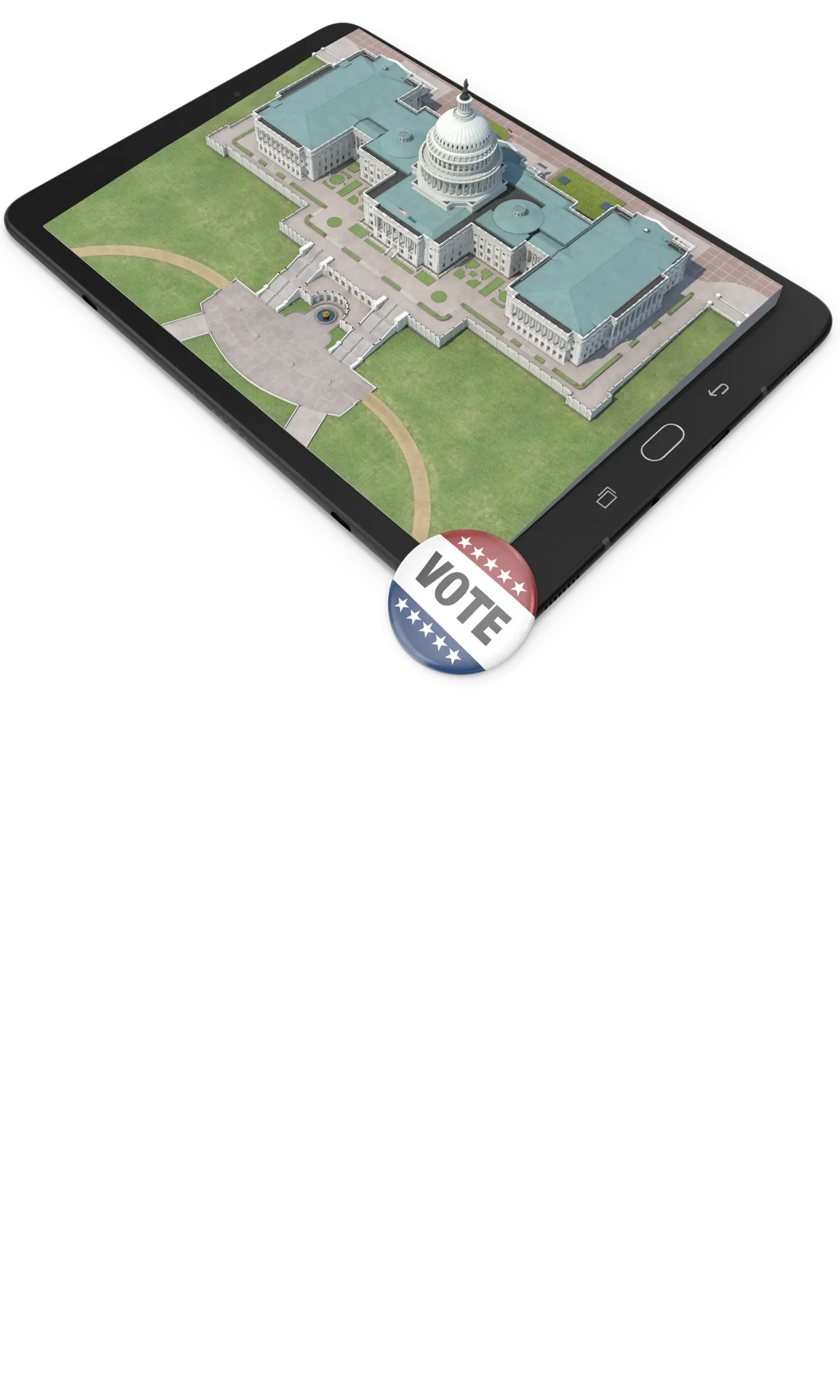
Articles & Guides
Digital Political Communication: doing politics in the age of social media
March 15, 2023

Articles & Guides
Digital PR: public relations in the digital age
March 15, 2023

Articles & Guides
Digital Public Affairs: how to employ effective institutional communication
March 15, 2023
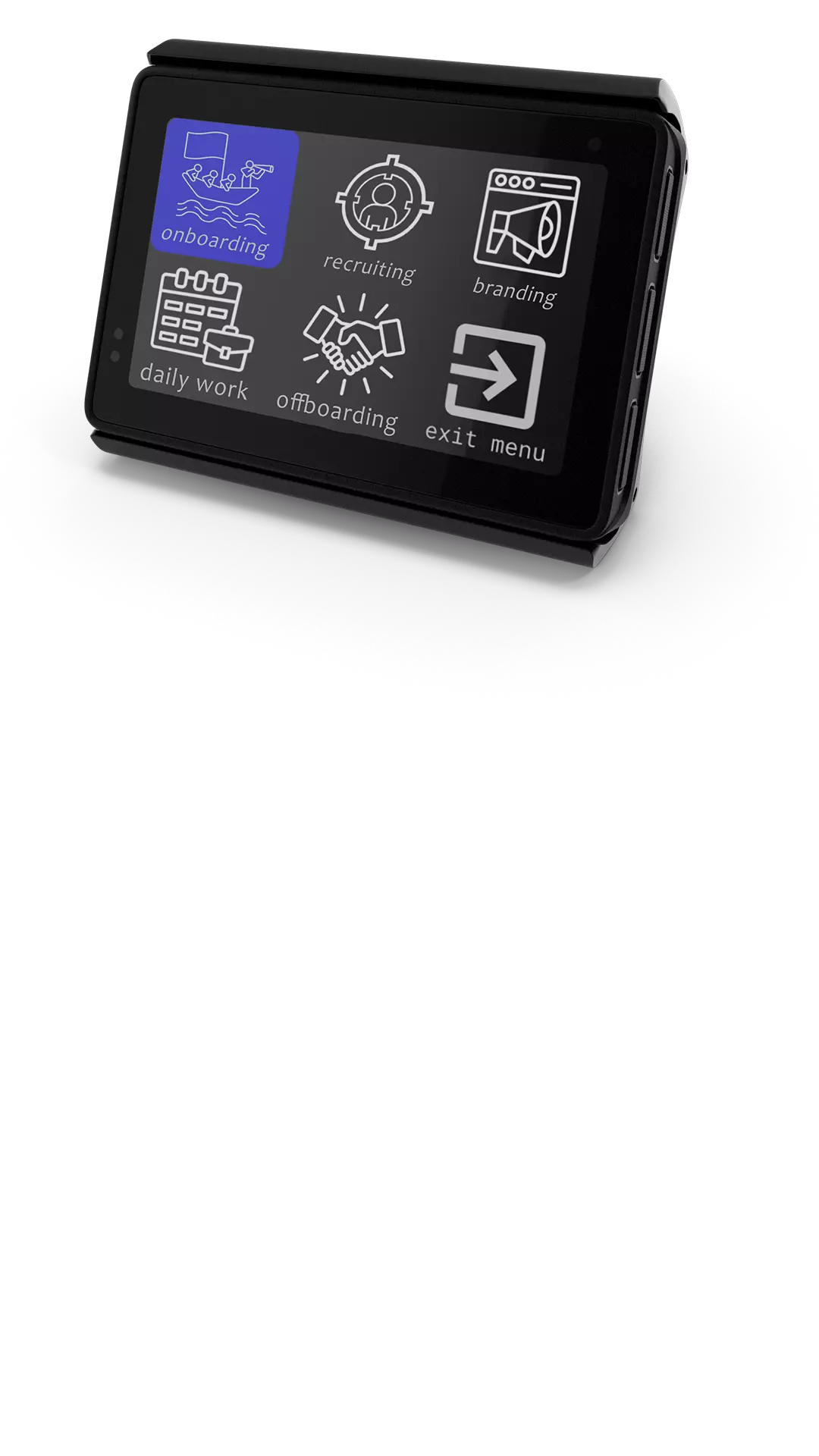
Articles & Guides
Digital Transformation for Human Resources: stages, tools and new skills
March 15, 2023
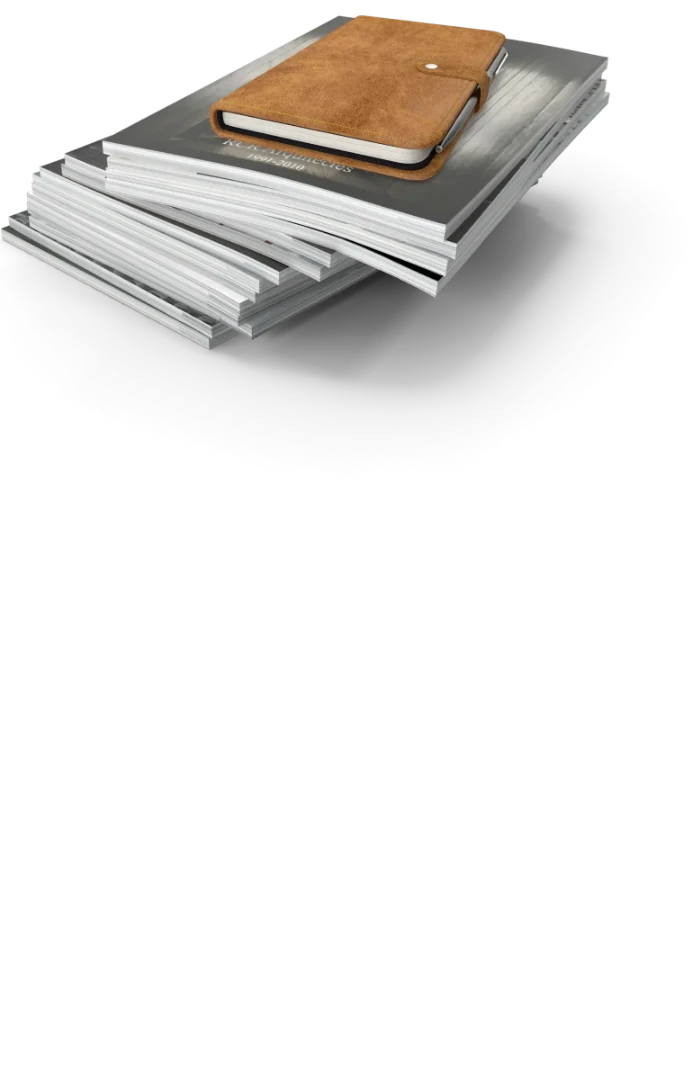
Articles & Guides
Editorial Plan: how to build a winning one
March 15, 2023

Articles & Guides
Employee Journey: how to track employee experience in 6 simple steps
March 15, 2023

Articles & Guides
Innovation Strategy & Innovation Management: best practice and examples
March 15, 2023

Articles & Guides
Digital Tools & Innovation Resources: the best sources for your innovation process
March 15, 2023


